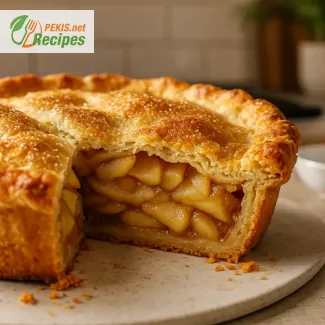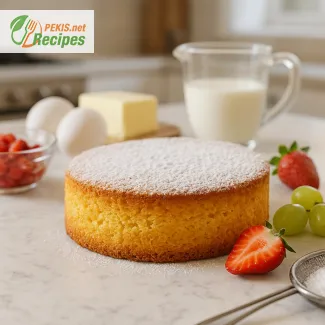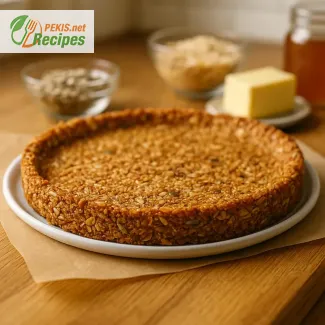Serves 8, with 30 minutes prep, 50 minutes baking, and a total of 80 minutes, this homemade apple pie with crispy crust delivers a golden, flaky pastry filled with tender, spiced apples. Balanced with cinnamon, nutmeg, and a hint of lemon juice, it offers both sweetness and freshness in every bite. The pie stays fresh for 2 days at room temperature, up to 5 days refrigerated, or 2 months frozen, making it ideal for holidays and family gatherings. Reheating at 150 °C (300 °F) for 8–10 minutes restores the crunch and warmth, ensuring each slice is as comforting as the first.
PEKIS – professional chef and recipe developer with more than 25 years of experience in baking, specialized in European and international cuisine. For this apple pie, I’ve drawn on years of working with traditional pastry techniques to perfect a crispy crust that holds a tender, spiced apple filling. My background with both rustic family desserts and refined patisserie helps bring out the balance of buttery layers, natural fruit sweetness, and aromatic spices in a way that feels both homely and timeless.

Classic homemade apple pie with a golden crispy crust
A timeless dessert with rich flavor and comforting texture
The aroma of a freshly baked apple pie filling the kitchen is one of those experiences that evoke warmth, family gatherings, and the joy of sharing food. A crispy crust paired with tender apples creates a balance of textures and flavors that has made this dessert a symbol of homemade comfort. With every slice, you taste the sweetness of fruit, the buttery flakiness of pastry, and the hint of spice that ties everything together.
The heritage of apple pie through history
Although often considered a traditional American dessert, the origins of apple pie can be traced back to Europe, where variations were enjoyed centuries ago. Recipes traveled across countries, adapting to regional ingredients and baking traditions. Today, the apple pie has become a global favorite, each culture adding its own twist — from lattice tops to streusel toppings or rustic galettes. This rich history highlights why apple pie is more than a dessert; it is part of a culinary heritage that connects generations.
Key elements that define the perfect apple pie
- Apples: Different varieties influence sweetness, acidity, and texture. Tart apples bring brightness, while sweet apples create a mellow richness.
- Butter-based crust: Cold butter cut into flour forms delicate flaky layers that stay crisp even after baking.
- Spices: Cinnamon, nutmeg, and cloves enhance the fruit’s natural depth, transforming simple apples into a fragrant filling.
- Sugar balance: Just enough sweetness brings harmony without overpowering the natural apple flavor.
- Texture contrast: A crisp outer shell with a tender, juicy interior keeps every bite interesting.
Why you’ll love this apple pie
- Crispy crust that stays light and golden
- Balanced sweetness with natural apple flavor
- Comforting aroma of cinnamon and spice
- A dessert suitable for holidays, family gatherings, or everyday indulgence
- Flexible recipe that allows creative twists
Storing and making ahead
Apple pie is easy to prepare in advance and keeps well when stored properly:
- At room temperature: up to 2 days, covered loosely with foil or a cloth.
- Refrigerated: up to 5 days for longer freshness.
- Frozen: up to 2 months; thaw overnight in the fridge before reheating.
- Reheating: place in a preheated oven at 150 °C (300 °F) for 8–10 minutes to restore the crispness of the crust.
Creative variations to try
- Caramel apple pie: drizzle caramel into the filling for extra richness.
- Nut topping: add crushed pecans or walnuts for a crunchy layer.
- Streusel style: replace the top crust with a buttery crumb topping.
- Mini pies: bake in small tart pans for individual servings.
- Cheddar twist: a slice of sharp cheese on warm pie, a classic pairing in some regions.
Related traditional recipes you might enjoy
If you are passionate about timeless desserts, there are also authentic versions available on our site:
- Slovenian Apple Strudel: Easy Homemade Jabolčni Zavitek with Traditional Taste
- Old-Fashioned Apple Pie – Classic Homemade Recipe
Flavor combinations and serving ideas
- Serve warm with vanilla ice cream or whipped cream for a classic touch.
- Pair with salted caramel sauce to highlight the natural tartness of the apples.
- Add a scoop of cinnamon gelato for a seasonal twist.
- Enjoy cold the next day for breakfast with a hot cup of coffee or tea.
Enticing apple pie in the context of culinary tradition
Beyond being a sweet treat, apple pie with crispy crust represents an enduring tradition. Passed from generation to generation, each version carries a personal story. Whether baked for festive occasions or as a simple weekend project, it has the ability to bring people together and spark nostalgic memories. That is why apple pie continues to be celebrated worldwide — not only as a dessert but as a meaningful symbol of home, family, and culinary craftsmanship.
- In a large bowl, combine the flour, salt, and cold butter. Rub together until the mixture resembles coarse crumbs.
- Add the ice water gradually and mix until the dough just comes together. Divide into two discs, wrap in plastic, and refrigerate for at least 30 minutes.
- For the filling, combine sliced apples, brown sugar, lemon juice, cinnamon, nutmeg, and cornstarch. Mix until apples are well coated.
- Roll out one disc of dough on a lightly floured surface and line a 23 cm (9-inch) pie dish. Trim edges if necessary.
- Fill the crust with the apple mixture, spreading evenly.
- Roll out the second disc of dough and place over the filling. Seal edges and cut small slits on top for steam to escape.
- Brush the top with beaten egg and sprinkle with sugar (decoration).
- Bake in a preheated oven at 190 °C (375 °F) for 45–50 minutes, until the crust is golden brown and crisp.
- Allow to cool for at least 1 hour before slicing to let the filling set.
FAQ questionWhat apples give the best texture and flavor?
Reach for a mix of tart and sweet apples to balance flavor and structure. Tart varieties bring bright acidity that keeps the filling lively, while sweeter, firmer apples hold their shape without turning mushy. Combining types also prevents a one-note flavor and helps the pie set with a juicy—but sliceable—texture.
FAQ questionHow do I keep the bottom crust crispy, not soggy?
Start with well-chilled dough and thoroughly dried apple slices (pat with paper towels). Dust the base with a thin veil of flour or cornstarch before adding filling, and make sure the filling isn’t watery. Bake on the lower rack so heat hits the base, and let the finished pie rest to allow starches to gel, which preserves a crisp bite.
FAQ questionWhich thickener should I use in the filling?
Cornstarch yields a clear, glossy set and a clean apple flavor. All-purpose flour produces a more opaque, rustic filling. Quick-cooking tapioca creates a firm, slice-clean gel that travels well. Whichever you choose, mix it evenly with the sugar and spices so it activates uniformly as the juices release.
FAQ questionWhat’s the secret to an extra-flaky, crispy crust?
Use very cold butter and handle the dough minimally to keep distinct fat pockets that steam and lift into layers. Add water a little at a time until the dough just holds together; over-hydrated dough bakes denser. Chill between steps—after mixing, after rolling, and before baking—for maximal flake and snap.
FAQ questionDo I need an egg wash, and are there alternatives?
An egg wash (lightly beaten egg) gives rich color and shine and helps sugar adhere. For an alternative, brush with milk or cream for gentle browning, or simple syrup right after baking for a subtle sheen. Sprinkle a little coarse sugar for extra crunch and sparkle.
FAQ questionHow far in advance can I assemble or bake it?
You can refrigerate assembled, unbaked pie for a few hours if the crust stays cold and the filling isn’t overly juicy. For longer make-ahead, freeze the unbaked pie on a tray, then wrap; bake from frozen, adding a bit of time. Baked pie keeps 2 days at room temperature, up to 5 days chilled, or 2 months frozen; reheat at 150 °C (300 °F) for 8–10 minutes to revive crispness.
FAQ questionLattice or full top—does it change the bake?
A lattice top vents more, so moisture escapes readily and the filling reduces slightly faster, often yielding a firmer set and deeply caramelized edges. A full top holds more steam, so cut vents to prevent sogginess. Whichever style you choose, watch for rich golden color and steady bubbling at the vents—both signal doneness.
A slice of homemade apple pie with crispy crust carries more than just flavor—it represents tradition, comfort, and the joy of baking something from scratch. The contrast between the buttery, golden crust and the tender, spiced apples creates a dessert that feels timeless yet adaptable to modern kitchens. Each bite combines sweetness, warmth, and a texture that keeps this pie a favorite for gatherings of all kinds.
The beauty of this dessert lies in its versatility. A classic recipe can be enhanced with streusel toppings, nut additions, or a drizzle of caramel sauce for richness. Whether served warm with ice cream or enjoyed cold the next day, apple pie maintains its charm and proves that simple ingredients, when handled with care, deliver extraordinary results.
The process of preparing this pie highlights the value of technique. Using cold butter, selecting the right apple varieties, and baking until the crust reaches perfect crispness are the details that elevate the outcome. These steps transform a basic set of ingredients into a dessert that balances flavor, texture, and aroma beautifully.
What makes this pie endure is not only its taste but also its place in cultural memory. Shared at family tables, celebrated during holidays, or baked as a weekend treat, apple pie continues to be a symbol of home and warmth. Its combination of tradition, comfort, and adaptability ensures that it will remain a centerpiece dessert for years to come.
Allergens present in the recipe:
- Gluten (wheat flour)
- Eggs
- Dairy (butter)
Tips for replacing allergens and gluten:
- Replace all-purpose flour with a certified gluten-free flour blend to make the crust suitable for gluten-intolerant individuals.
- Substitute butter with dairy-free margarine or coconut oil for a lactose-free version.
- Use a plant-based egg replacer (such as flaxseed mixture) instead of egg wash.
- Vitamin C: 6 mg – supports immune function and skin health
- Vitamin A: 75 IU – beneficial for vision and cell growth
- Calcium: 20 mg – contributes to bone and teeth strength
- Iron: 1 mg – essential for red blood cell formation
- Potassium: 210 mg – helps regulate fluid balance and muscle contractions
- Magnesium: 12 mg – important for muscle and nerve function
- Polyphenols (from apples): 100 mg – may reduce inflammation and improve heart health
- Flavonoids (from cinnamon and apples): 45 mg – support vascular health and lower oxidative stress
- Carotenoids (trace amounts from apples): 20 mcg – contribute to eye and skin health





